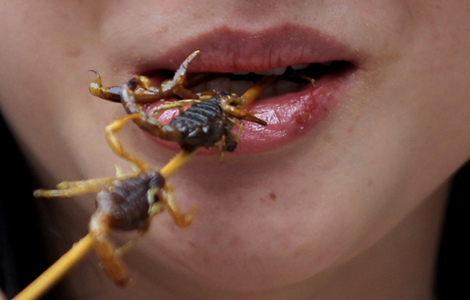It's been a panda-ful year
Updated: 2013-10-04 09:10
By Amy He (China Daily)
|
||||||||
Pandas in zoos everywhere are greeted with a chorus of "oohs" and "aahs" over their cuteness, but some conservationists say that the bears attract far more attention and funding than other endangered animals, reports Amy He in New York.
Nobody hates pandas.
How can they, when the bumbling cuteness of the slow-plodding, bamboo-eating bear is what helped propel it to become a global conservation icon? And this year has seen plenty of panda births, from China to the US capital.
Like the endangered bald eagle and the humpback whale, the panda is considered one of the "charismatic" species, well known and instantly recognized animals that conservationists use to attract the public's attention - and hopefully financial support - to conservation causes.
|
Fourteen giant panda cubs, all born this year, make their debut at the Chengdu Research Base of Giant Panda Breeding on Monday. The base said its 128 pandas form the world's largest captive panda population. Huang Zhiling / China Daily |
Despite all the fans the panda has - which was demonstrated by the outcry when the Washington zoo turned off its panda cam this week due to the government shutdown - the panda still hasn't won over everybody. Some conservationists are concerned about how the bear attracts more attention and funding than other endangered animals - disproportionate to their reproductive successes.
"I'd eat the last panda if I could have the money we've spent on panda conservation back on the table for me to do more sensible things with," said British naturalist Chris Packham in 2008. He went on to say that the panda is "possibly one of the grossest wastes of conservation money in the last half century. The panda is, unfortunately, virtually unsavable. It lives in the most overpopulated country in the world, it feeds on plants when it ought to be eating partially meat, it transfers all sorts of nasty diseases among itself, it tastes nice and it's got a coat that looks good on someone's back."
And more recently, Jacob Lentz and Steve Nash - who humorously grade animals based on their usefulness to the Earth and ability to survive in their book The Animal Review: The Genius, Mediocrity, and Breathtaking Stupidity That Is Nature published in 2010 - gave the panda an "F":
"Much ado is made about the plight of the panda. Pandas are endangered due to their habitat destruction, the Chinese tradition of poaching, and a hilarious low birth rate.
"This has prompted aggressive captivity-breeding programs. These never work, because getting pandas to mate is like launching a satellite into orbit.

"Every so often captive pandas will mate (always by accident), and the local news then runs endless loops of a gross panda cub in an incubator as it plots a life of not mating. While everyone worries about the panda's future, any objective observer is led to the conclusion that perhaps its time has passed. Maybe Nature is trying to give them the hint that they need to go the way of the dodo, and maybe we should spend our time on a species that at least wants to survive.
Valuable space
"In the meantime, pandas occupy valuable zoo space and consume prodigious amounts of bamboo that could otherwise be used to produce offbeat furniture. Way to be, Gao Gao."
The authors and researchers of Giant Pandas: Born Survivors, Zhang Zhihe and Sarah Bexell, also worry that people are attracted to the panda in an almost crazed way. Apart from the panda, they wrote, other species don't get the frenzy of attention that people have given the bear; people rarely announce the births, deaths and locations of other captive species in the same obsessive degree they do for pandas.
"While scientists and conservationists appreciate the attention to work being done to promote awareness of captive panda issues, it is somewhat disturbing that the focus is on one species," they write in their book published this year.
To panda detractors and worried conservationists, expending energy on animals that are meant to die out is a waste because they say the efforts take resources away from animals that may have a better chance of survival.
But to others devoted to the panda conservation cause, using the charismatic black and white bear is the perfect kind of pragmatism.
"Conservation is a very practical framework. Our goals are to preserve wildlife and if we want to be successful as conservationists, we have to take a very practical approach," said Megan Owen, a conservation program specialist at the San Diego Zoo. "The form that pragmatism takes will vary from situation to situation."
"Pandas are a conservation ambassador and anyone who's involved in panda conservation understands the cascading impact that panda conservation has, because not only are you working to save giant pandas, but people pay attention to panda conservation," she said. "People who are not necessarily interested [in conservation] might be more interested because it's about giant pandas. It provides an incredible opportunity for us to share with the general public the complexities of conservation."
Asked if she thought pandas attracted a disproportionate amount of funding compared to other animals, Owen said that what helps pandas ultimately helps other species: "Much of what we do with giant pandas - the techniques, the strategies, the connections - we can apply beyond giant pandas, we can make the same connections to support other wildlife and other wild habitats."
There might be a "perceived inequity," Owen said, "but ultimately our job is to make sure that [in the] long-term it serves the greater purpose of conservation."
Serving a greater purpose is especially apt for an animal like the panda since it is considered to be one of the classic umbrella species: protecting the panda protects other species that exist within the umbrella species' natural ecological systems, said Owen. Owen described the panda as a "large-ranging animal," one that inhabits large habitats - in this case, high-altitude forests in China after being driven out of the lowlands by human activity. Preserving that animal within those large habitats, means that "numerous other species will have a greater chance at preservation because of the habitats for the larger animals", she said. Some of the animals living in the same habitat as the giant panda include Sichuan golden snub-nosed monkeys, red pandas and golden pheasants, as well as 12,000 plant species.

 Driver shot dead in car chase at US Capitol
Driver shot dead in car chase at US Capitol
 NY SUV driver's wife: We were in 'grave danger'
NY SUV driver's wife: We were in 'grave danger'
 Death toll in sunk boat off Italy could top 200
Death toll in sunk boat off Italy could top 200
 A southern staple
A southern staple
 Tropical Storm Karen aims for US Gulf Coast
Tropical Storm Karen aims for US Gulf Coast
 City rush, island time
City rush, island time
 Death toll in Italy migrant boat wreck rises to 94
Death toll in Italy migrant boat wreck rises to 94
 Lang Lang: First Chinese winner of Classic Brits Award
Lang Lang: First Chinese winner of Classic Brits Award
Most Viewed
Editor's Picks

|

|

|

|

|

|
Today's Top News
Obama cancels APEC trip due to gov't shutdown
US hints Iran could get some sanctions relief
Twitter unveils IPO filing, aims to raise $1 b
Hundreds dead as boat sinks off Italy
Gunfire forces brief lockdown at US Capitol
NY driver's wife says in danger
Call for new 'maritime silk road'
Shutdown in third day
US Weekly

|

|







